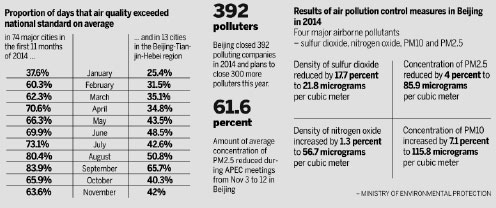Strict controls help clear the air
By ZHENG JINRAN (China Daily) Updated: 2015-01-12 07:47

The capital is also considering making the odd-even license plate traffic restriction, which was implemented during the Asia-Pacific Economic Cooperation meetings, a permanent restriction.
During the event, from Nov 3 to 12, air quality was mostly maintained at healthy levels in Beijing.
The average concentration of PM2.5 during the period was reduced by 61.6 percent because of measures that included the suspension of work at construction sites and polluting companies in the Beijing-Hebei-Tianjin region.
"The measures to rein in vehicle exhaust made up 39.5 percent of the reduction of PM2.5 emissions and proved that our controls were effective," said Fang Li, deputy director of the Beijing Municipal Environmental Protection Bureau.
Regional cooperation among Beijing and surrounding areas was a major reason the green objectives were met, he said.
Measures to control air pollution should be part of the improved mode of economic development, and the government should upgrade the economy with environmental protection in mind, said Minister of Environmental Protection Zhou Shengxian.
China lowered its annual GDP growth forecast to 7.5 percent at the beginning of 2014, and priority was given to upgrading the economy in line with high-quality growth and clear goals to reduce pollution.
Last year, many cities adopted plans to restructure and control the growth of polluting companies.
Beijing closed 392 polluting companies in 2014 and plans to close 300 more polluters this year. The government also plans to promote advanced technologies for companies to cap emissions and upgrade their products and services.
Hebei, where heavy industries are a major contributor to economic growth, has required core yet polluting industries such as the iron, steel and cement sectors to slow down by closing some plants and setting emissions caps.
With such deep cuts to industrial production, the central government has allocated funds-as much as 10 billion yuan ($1.6 billion) last year to encourage more initiatives from local governments to optimize their economy for "green GDP".
However, experts have expressed concern over the country's capability to meet its target for improving air pollution.
The current measures might not help the Beijing-Hebei-Tianjin region lower their concentration of PM2.5 as planned, according to a report released in September by Tsinghua University and the Clean Air Alliance of China.
"More stringent measures should be implemented, and the joint efforts in the region can be strengthened to promote the reduction of emissions," said He Kebin, a professor of environmental science at Tsinghua University.
- Days of qualified air expected to reach 340 in 2015: Xiamen's new plan
- Zhanjiang to release real-time air quality data
- More Chinese cities to have real-time air quality readings
- Pollution control slashes GDP growth in Hebei
- Beijing had 45 heavy pollution days in 2014
- Shanghai gets stronger law to curb pollution
- China imposes record fine in water pollution case
- Stronger pollution law takes effect this week
- Govt encourages people to work 4.5 days a week
- Action to be taken as HIV cases among students rise
- Debate grows over reproductive rights
- Country's first bishop ordained in 3 years
- China builds Tibetan Buddhism academy in Chengdu
- Authorities require reporting of HIV infections at schools
- Typhoon Soudelor kills 14 in East China
- Police crack down on overseas gambling site
- Debate over death penalty for child traffickers goes on
- Beijing to tighten mail security for war anniversary







